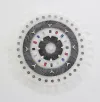PACIFIC NOTION: 20 Years On
Lianne Edwards, Niki Hastings-McFall, Ioane Ioane, Lily Laita, Kenneth Merrick & Raymond Sagapolutele
10 – 29 June, 2018
Opening: Sunday 10 June, 2pm – 4.30pm
A stocktake
Lana Lopesi
In 1998, Pacific Notion, at the Melbourne Art Fair introduced the commercial art market to the work of Niki Hastings-McFall, Ioane Ioane, Fatu Feu’u, Andy Leleisi’uao, Dagmar Dyck and Lily Laita. Organised by Deborah White the stall occurred at a time where the commercial representation of Pacific art and artists was fairly non-existent, despite the depth and breadth of Pacific art production occurring in the 1990s. Fast forward 20 years to 2018, Whitespace, from their new gallery presents Pacific Notion: 20 Years On, including the work of the original Pacific Notion artists, Niki Hastings-McFall, Ioane Ioane and Lily Laita, as well as, Kenneth Merrick, Lianne Edwards and Raymond Sagapolutele.
While each of the six artists have very diverse practices amongst themselves, what is perhaps most important about this exhibition is the space it offers up for us to run a stocktake of Pacific art in Aotearoa New Zealand. Major changes are occurring at Tautai Contemporary Pacific Arts Trust and Creative New Zealand is revaluating the ways in which they should be supporting Pacific art, leading to one core question, what support does Pacific art and do Pacific artists need in 2018?
Pacific art in Aotearoa New Zealand in 2018 is healthy. I say that as we reflect on having Luke Willis Thompson win the 2014 Walter’s Prize, the same year that Kalisolaite ‘Uhila was nominated, with the only Pacific finalist prior to that being Edith Amituanai in 2008. We are starting to notice (although it’s very marginal) more Pacific artists being represented by dealer galleries and more work being acquired by our public institutions. Toi Art, Te Papa’s revamped contemporary art galleries reopened with two major exhibitions by Pacific artists, The Pacific Sisters and Tiffany Singh, as well as commissioning new work by Janet Lilo and Sopolemalama Filipe Tohi. We now have three Pacific curators in generalist curatorial roles at Waikato Museum Te Whare Taonga o Waikato, Te Uru Waitakere Contemporary Gallery and Rotorua Museum Te Whare Taonga o Te Arawa. We are starting to read more Pacific voices in arts criticism. And more and more young Pacific artists are graduating from our universities. And as a result of these milestones, in 20 years the conversation has shifted majorly.
In 1998, Pacific art conversations had already shifted to a new, younger, urban generation. Moving away from the migration narrative of Pacific artists in the 1970s, this new 90s generation sought to reconfigure, re-describe and re-atheticise what it meant to be Pacific in diaspora. A few factors separated this generation from the previous one, for starters many of them were New Zealand born and therefor the product of urban Auckland and New Zealand and amongst this generation an art school experience was much more common. They were witnesses of artists before them, as well as social movements such as the Polynesian Panthers. Here, the narrative of the Pacific experience widened from interrogating effects of colonisation and highlighting harsh realities for Pacific people in New Zealand to experimental and innovative new ways of discussing culture through performance art and fashion.
With the health that I outlined above comes politics, factions and complexity. The very question of what it means to be Pacific, a Pacific artist or just an artist has no one answer and nor should it. Three generations deep of Pacific artists means that the ways in which we understand and locate ourselves are more complex and multi-layered than ever. Today, twenty years on from the 90s I would say we’re in a new conversation again focused on the interrogation of power and structures. Where the earlier two generations relied on collaborating and working with non-Pacific allies, the landscape has shifted so Pacific people are now in more powerful positions as curators, writers and administrators. Questions of who has what right to be a part of the community are swirling. That is assuming there is one community to which we all belong.
The question of what support does Pacific art and do Pacific artists need in 2018? May have obvious answers to some, but personally it seems in part like an impossible question. With so many subsets within the current Pacific art community and so many varied needs, offering yourself up to everyone just means there are those who will always be let down. Perhaps what is of most importance now is rather than zooming out to understand Pacific art as sitting within a single umbrella, to really focus in acknowledging the complexities, the depth and the breadth, so that all Pacific artists and their work is included.

















